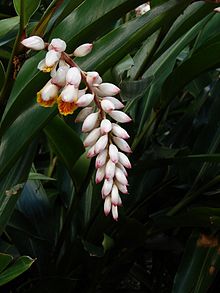Alpinia

Alpinia is a genus of flowering plants in the ginger family, Zingiberaceae. It is named for Prospero Alpini, a 17th-century Italian botanist who specialized in exotic plants.[1] Species are native to Asia, Australia, and the Pacific Islands, where they occur in tropical and subtropical climates.[2] Several species are cultivated as ornamental plants.[3] Species of the genus are known generally as shell ginger.[3][4]
These herbs lack true stems, but have pseudostems usually up to about 3 metres (9.8 ft) long which are composed of the overlapping leaf sheaths.[2][3] A few species have been known to reach 8 metres (26 ft).[5] They grow from thick rhizomes. The leaves are lance-shaped to oblong. The inflorescence takes the form of a spike, a panicle, or a raceme. It may be hooded in bracts and bracteoles. The flower has a shallowly toothed calyx which is sometimes split on one side. The flower corolla is a cylindrical tube with three lobes at the mouth, the middle lobe larger and hoodlike in some taxa. There is one fertile stamen and two staminodes, which are often joined into a petal-like labellum, a structure that is inconspicuous in some species and quite showy in others. The fruit is a rounded, dry or fleshy capsule.[2][3] The plants are generally aromatic due to their essential oils.[6]
Most Alpinia are plants of forest understory habitat. Most are pollinated by large bees, but some are pollinated by birds and bats.[5]
